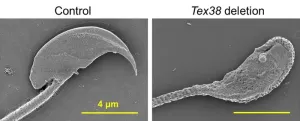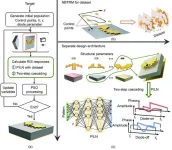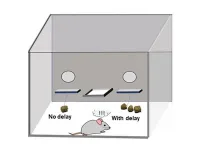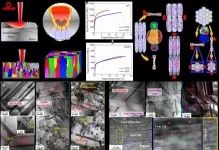(Press-News.org) When sea otters were reintroduced along the coastlines of islands in Southern California and British Columbia, researchers saw kelp forests return to areas that were destroyed by sea urchins. But how slow or fast they grew back depended on the location — and until now, scientists didn’t understand why.
New CU Boulder research found sea otters, an important keystone species, play a vital role in kelp forest recovery, but their level of influence depends on what other species they interact with in salty Pacific Ocean waters. The study, published today in PNAS, used decades of observations to create a time series of interactions, like a movie that shows changes in the numbers of the local species, and crucially, the patterns of how they interact through time, to understand how the reintroduction of sea otters helped Pacific Ocean kelp forests recover.
“We always thought keystone species control their ecosystem the same way, regardless of where they are or what else is in the ecosystem,” said Ryan Langendorf, lead author of the paper, Environmental Studies researcher, and former postdoctoral researcher at CIRES. “A more modern view is that they are still very important, but they can have different effects in different places.”
Researchers' fascination with keystone species spans decades. Jim Estes, a retired USGS scientist and the paper’s co-author, spent his career researching sea otters and how their presence along rocky shorelines shaped kelp forests. While working on remote Alaskan islands, he found where sea otters were absent, sea urchin populations mushroomed, overtaking kelp forests. He concluded the small mammal was integral to maintaining harmony in coastal reef ecosystems: by feeding on sea urchins they in turn maintained the health of kelp forests — dense groups of brown algae that are rich in biodiversity and provide shelter to many species.
Estes, University of British Columbia researcher Jane Watson, and other co-authors of the study led two 30-year data community collection studies documenting what happened after reintroducing sea otters to Nicolas Island in California in the 1980s and Vancouver Island in British Columbia in the 1970s. The data sets represent two of the most complete studies looking at the effect of keystone species on local ecosystems. Both research areas were mostly “urchin barrens” — sites where sea urchins had overgrazed in the absence of sea otters — when the studies began.
Thirty years of data revealed that while kelp forests grew back in both locations, forests in British Columbia regenerated much faster than in Southern California. British Columbia was a classic example of the domino effect, which ecologists call a trophic cascade, that comes with reintroducing a keystone species: otters eat urchins, so kelp can regrow. But the slower return in the south revealed a gap in understanding.
To understand these differences, Langendorf developed a novel community model that created a movie of species interactions, to understand the changes in the ecosystem over the 30 years at both sites.
Creating the movie provided researchers with answers. The model highlighted how all living things — sea otters, urchins, kelp — interacted over time in both regions. This revealed more competition between the different urchin, kelp, and other species in California, which slowed down the influence sea otters had on the entire system. In short: sea otters in California didn’t have as strong of an effect on sea urchins as they did up north because of the complex web interactions that took place in the Canadian ecosystem.
“Almost all studies of ecological communities assume that these interaction strengths are static – that “the rules of the game” don’t change even as the abundances of species do,” said CU Boulder Environmental Studies professor and co-author of the paper, Dan Doak. “By developing a way to estimate these changing rules, Ryan has added to our appreciation of this particular system, as well as pioneering a more powerful way to understand other ecological systems.”
The new model can help researchers better understand how ecosystems change when species are reintroduced to places that are constantly changing and evolving.
“The dynamic nature of ecosystems has long kept ecologists from understanding what species need and how best to manage them,” Lagendorf said. “Being able to turn common survey data into a movie of species reacting to changes in their environment and each other feels like renewed hope for a field that more than ever needs to offer useful advice about how to help the many complex living systems we live with and cherish.”
END
Sea otters help kelp forests recover — but how fast depends on where they are
2025-03-03
ELSE PRESS RELEASES FROM THIS DATE:
Study links intense energy bursts to ventilator-induced lung injury
2025-03-03
A new study from Tulane University suggests that repeated collapse and reopening of tiny alveoli—air sacs in the lungs essential for breathing—during mechanical ventilation may cause microscopic tissue damage, playing a key role in ventilator-related injuries that contribute to thousands of deaths annually.
Published in the Proceedings of the National Academy of Sciences (PNAS), the study sheds light on ventilator-induced lung injury, a complication that gained increased attention during the COVID-19 pandemic, which led to a surge in patients requiring ...
Uncovering the protein complex critical to male fertility
2025-03-03
Osaka, Japan – The human body is full of checks and balances that ensure correct growth, development, and function of all our different systems. Now, researchers from Japan have reported a newly discovered protein interaction that regulates sperm development.
In a study to be published soon in PNAS, a multi-institutional research team led by Osaka University has revealed that the interaction between two specific proteins is crucial for ensuring that sperm cells develop properly.
Sperm formation is a highly complex process that involves many changes ...
Scientists discover how a naturally occurring mechanism hampers fertility
2025-03-03
A Yale-led research team has uncovered how a naturally occurring biological mechanism found in mammals is able to prevent sperm cells from interacting with an egg, preventing fertilization.
The discovery, identified in rodent models, offers a new path for scientific research to help people grappling with infertility issues, while also opening a new line of study for developing contraceptive therapies. The findings appear in the journal Proceedings of the National Academy of Sciences.
“This will have direct implications ...
Integrated framework for ecological security: A case study of the Daqing river basin
2025-03-03
In a recent study published in Engineering, researchers have developed an innovative analytical framework for ecological security assessment, prediction, and zoning management. Guided by the Social–Economic–Natural Complex Ecosystems (SENCE) theory, this framework aims to enhance ecological security for sustainable development.
The Daqing River Basin in the North China Plain was chosen as a case study due to its ecological significance and the increasing human-land conflicts. The research team established an assessment index system based on the pressure-state-response ...
New design paradigm boosts reconfigurable intelligent surface efficiency
2025-03-03
A recent study published in Engineering introduces an innovative design paradigm for reconfigurable intelligent surfaces (RISs), aiming to enhance their design efficiency and versatility. This research, led by a team of scientists from Southeast University and Guangzhou University, offers a fresh approach to address the challenges in RIS design.
RISs, enabled by digital coding technology, are crucial for manipulating electromagnetic (EM) waves in real-time. They play a significant role in 5G and 6G research. However, traditional automatic RIS design methods face issues. Most involve extensive numerical simulations ...
Long-term cocaine use may increase impulsivity
2025-03-03
Researchers have widely accepted that impulsivity increases the risk of drug addiction, but the evidence to support this belief is mixed. Exploring the relationship between impulsivity and cocaine use in rats, Yihong Yang and colleagues from the National Institute on Drug Abuse found evidence that contradicts the prevailing view that high impulsivity predicts cocaine use.
One classification of impulsivity is impulsive choice, which can be studied with risky choice tasks and delay-discounting tasks (DDT). During DDT, impulsive individuals prefer smaller, ...
How London’s Ultra Low Emission Zone is changing the school run
2025-03-03
London’s Ultra Low Emission Zone (ULEZ) is transforming children’s journeys to school by making streets safer, improving perceptions of air quality and encouraging children to live healthier lives. A new study published today in BMJ Open, and funded by the National Institute for Health and Care Research (NIHR), highlights its benefits, with many families noticing cleaner air and safer roads. However, it also reveals challenges, particularly for those living in outer boroughs who are more reliant on the car and may struggle to adapt.
Road traffic is a major source of air pollution in London, posing serious health risks. One in 11 children in the city has asthma, a condition ...
Breakthrough CRISPR-based test offers faster, more accurate diagnosis for fungal pneumonia
2025-03-03
Tulane University researchers have developed a CRISPR-based test that diagnoses Pneumocystis jirovecii pneumonia (PJP) — a life-threatening fungal infection primarily affecting children and immunocompromised patients — more quickly and less invasively, according to a new study published in the Journal of Clinical Investigation.
The highly accurate test detects RNA from live fungi in blood samples and throat swabs, eliminating the need for invasive bronchoscopy procedures currently used for diagnosis.
"Current diagnostic methods haven't evolved in ...
3D-printed knee implants improves quality and reliability
2025-03-03
Customized 3D-printed medical implants are becoming more common, and a new study has taken this technology to the next level. Researchers at Naton Biotechnology have developed the world’s first laser 3D-printed total knee implant, which has received official approval from China’s National Medical Products Administration as an innovative medical device.
The study focused on improving the strength and consistency of cobalt-chromium-molybdenum (CoCrMo) alloy implants made using laser powder bed fusion (LPBF), a 3D printing process. The team discovered and corrected inconsistencies in the structure of the material ...
UC San Diego innovators to spotlight transformative science at SXSW 2025
2025-03-03
The South by Southwest (SXSW) Conference and Festivals — a renowned convergence of pioneers, storytellers, and global visionaries — will take place this year from March 7-15 in Austin, Texas, bringing together a vibrant mix of ideas and innovations. Once again, UC San Diego will take center stage, showcasing cutting-edge research, transformative discussions on critical global challenges and a film premiere.
“UC San Diego’s participation in the 2025 South by Southwest Conference and Festivals reinforces our institution’s passion for interdisciplinary ...





